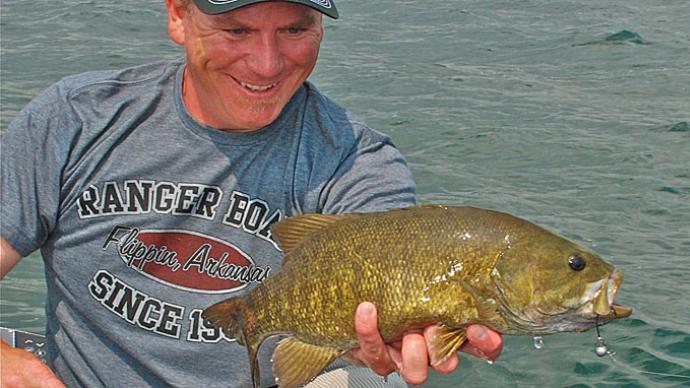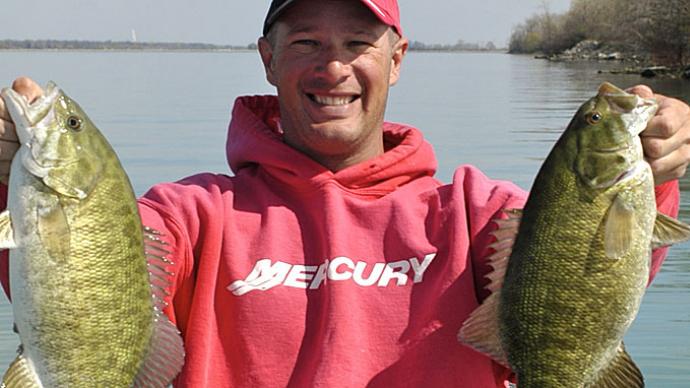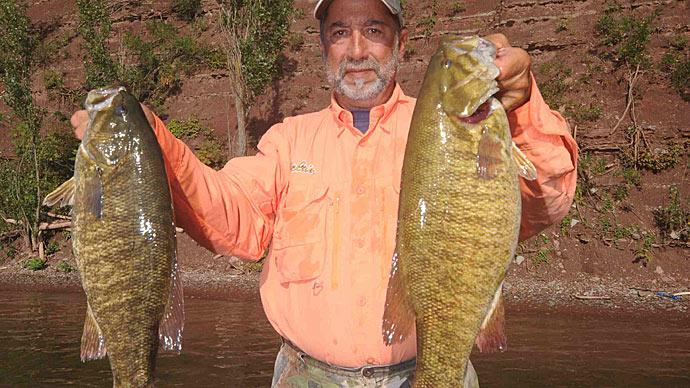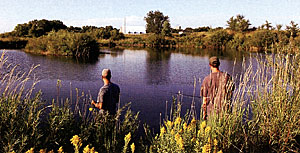
At last! After 13 years we've finally been able to rein back the ever-burgeoning, out of control smallmouth bass population in a South Dakota gravel pit! After years of harvest efforts from seining to fishing, often feeble attempts to reduce numbers of too many small fish in order to grow larger fish, we finally added prey management to the equation.
Drum roll, please. Enter the pumpkinseed sunfish!
Smallmouth bass are great fun in pond management. However, thanks primarily to discussions on the Pond Boss Forum (www. pondboss.com), we realize that smallmouths in ponds can be quite different in northern and southern climates. In many southern ponds, we understand that smallmouth bass often do not reproduce very well, or at least those young bass do not survive their first year very well. Missing year classes area common problem in the South. In contrast, we find that smallmouth bass commonly overpopulate in the north. What results is a high density population with slow growth and a pond full of small bass. Does that sound familiar to our southern readers when it comes to largemouth bass? We bet it does. Largemouth bass most often do the same thing in southern (and northern!) ponds.
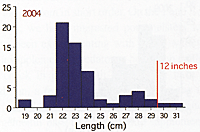
North Pond is a private, half-acre gravel pit located in eastern South Dakota (Figure 1). This pit and two others on the property have been studied by students at South Dakota State University (SDSU) since the late 1980's. This gravel pit is dug into the groundwater table, and water quality is excellent. Clear water allows fish to easily be observed. During excavation, an island was left in the center of the pond to provide additional habitat.
The fish community of North Pond has undergone several changes over the past 20+ years. Most recently, the pond has been managed as a smallmouth bass-only fishery because of its sand/gravel substrates. North Pond was stocked with smallmouth bass in the spring of 1997, following a rotenone renovation. Surveys from 1998, 2000 and 2002 indicated that the stocked smallies were reproducing and recruiting (surviving to adult size) very well. Perhaps too well! Due to the pond's abundant spawning habitat, recruitment was high and the pond was becoming densely populated. In 2002, SDSU students estimated the smallmouth bass biomass was a surprising 486 pounds/acre. That's about 243 total pounds in this approximately half-acre pond. Quite surprising. Previous work in Illinois had led us to expect less than 100 pounds/acre for smallmouth bass.
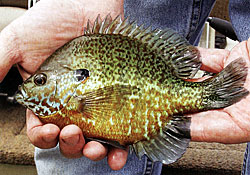
These abundant smallmouths also exhibited slow growth, which the students attributed to competition for resources such as food. At this time (2002), the population size was estimated at 613 individuals. However, very few were over 12 inches long. The high population density was likely prohibiting growth to larger sizes. There were simply too many mouths and too little food. Thus a removal program was initiated in 2002. A total of 297 individuals were removed from the population by angling during the first effort. As you might guess, it wasn't difficult to get a crew of students to "volunteer" for fishing. This removal was nearly half of the estimated population size! This certainly helped to reduce density in the short term, but by 2004 the population was again considered dense and slow growing. The fish reproduced and filled the gap created by harvesting fish. Furthermore, only two individuals surveyed that year were over 12 inches long! (Figure 2) Therefore, another large removal was completed in 2004. This time a total of nearly 400 individuals were removed! Most of the smallies ranged from 6 to 12 inches and the few over 12 inches were returned to the pond. These removal efforts were designed to reduce competition for limited resources and promote growth, but were not effective over the long term. In this pond as well as several other study ponds, our infrequent removal efforts just were not enough to improve the quality of the smallmouth bass fisheries. A new thought seemed necessary!
A new approach was taken in 2005. That summer, 11 adult pumpkinseeds were stocked (Figure 3). Why only 11 at that time? Well, that was all we could obtain. Pumpkinseeds are not a common fish in South Dakota. They are much more common just to our east, in Minnesota.
Let's take a moment and discuss the pumpkinseed. Just what are they? Well, they are the snail-eating sunfish of the north. Just like their cousin the redear sunfish, which lives in a warmer climate, the pumpkinseeds have the capability to crush snail shells. As a result, they can feed extensively on snails. They also will feed on aquatic insects and zooplankton, just like most sunfishes, but especially if you put them into competition, they really will specialize on snails.
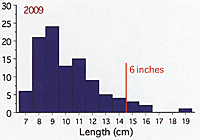
So, is the pumpkinseed the redear of the north? Not by a long ways! Redear sunfish have a naturally low reproductive capacity. They almost never overpopulate, and they seem to reach large sizes in most all populations. In contrast, the pumpkinseeds have a much higher reproductive capacity. As a result, they commonly overpopulate and stunt. Because of this fact, we actually were a little hesitant about stocking them into the gravel pit. Smallmouth bass are not as effective a predator as largemouth bass. However, we hoped that in the clear water of this steep-sided gravel pit, the pumpkinseed would be sufficiently vulnerable to smallmouth bass predation.
These 11 individuals were intended to serve as the foundation for a prey base with the potential added benefit of providing a quality pumpkinseed fishery. The removal program for small smallmouth bass was continued in 2006 and 2007, with over 300 and 30 individuals removed, respectively. Beyond these removals there was little alteration to the community from 2007 to 2009.
In 2009, we again surveyed North Pond to determine the success of the pumpkinseed introduction and past smallmouth removals. Again, we sampled by angling. Amazingly, even with the help of SDSU's finest anglers, only 30 total smallmouths were caught. We estimated the population size to be only 54 individuals (3 inches and longer), with a biomass of 95 pounds/acre. These estimates are far lower than the 2002 estimates of 613 fish and 486 pounds/ acre. It appears our efforts had finally paid off! The density of smallmouth bass in North Pond had finally been reduced.
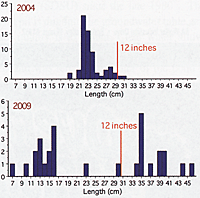
Compare the sizes of smallmouth bass caught by angling in 2009 with those back in 2002 (Figure 4). What a difference! The 12 to 18 inch smallmouths were back in 2009. It certainly appears that the addition of pumpkinseeds was the key. However, we honestly can't separate the pumpkinseed effects from the fact that we also continued the smallmouth bass removals. Regardless, the combination of pumpkinseeds as prey and the persistent removals enabled individuals of the population to reach larger sizes.
What about the pumpkinseed size structure? After all, recall that we were uncertain if the smallmouths would be an effective predator to keep pumpkinseeds from overpopulating. Unfortunately, the dream of a quality pumpkinseed fishery was somewhat dashed. Very few of the 200+ pumpkinseeds we caught exceeded 6 inches (Figure 5). However the population is reproducing naturally and obviously providing the prey base needed.
Now, one of the biggest concerns with overpopulated or "stunted" sunfish is that they can affect reproduction and survival of the predator. That certainly is true with largemouth bass and bluegills. So, that was indeed one of our concerns for this little experiment. If you take a look back at Figure 4, note those smallmouths from 7 cm up to 23 cm (3 to 9 inches). Those probably represent fall-collected age-0, age-1 and age-2 smallmouth bass. Thus, at least so far, the smallmouths seem to be recruiting, despite the pumpkinseeds. A few more years of monitoring will really be necessary to know if that smallmouth bass success continues.
So was this overall management effort successful? Well, it probably depends on the management objectives for the pond. If a quality smallmouth bass fishery is desired, then we are at a better place than we have been since the pond was stocked with smallmouths. 18-inch smallies are a blast to catch! If a quality panfishery was the objective, then we apparently missed on that one. Based on our analysis of the pumpkinseeds, they had a very high density, slow growth and very few were of sizes that would interest an angler.

We think this study has some general implications for pond management, even though we consider it a work in progress. Pumpkinseeds are much like bluegills in their multiple-spawning nature, so we can probably speculate a little here. If a person owns a pond with moderate levels of submergent vegetation, we're going to stick with the long-term recommendation that the smallmouth bass-bluegill combination is not a good one. As we mentioned earlier, smallmouths just don't have the same predatory capability as largemouth bass. However, if a person has a pond with little or no vegetation (either naturally or because of grass carp), then perhaps the smallmouth bass-pumpkinseed or smallmouth bass-bluegill combination might be tried on an experimental basis. We suspect that quality of the panfish will be poor, but you may end up with an effective strategy for producing larger smallmouths. The primary risk is that the sunfish will overpopulate and inhibit natural recruitment of your smallmouths. If this happens, a relatively easy corrective strategy would be to introduce largemouth bass adults, who likely would clean up the problem in short order. On the Pond Boss Forum, we have interested pondmeisters who have been experimenting with a few walleyes as a supplemental predator to help keep panfish in check in ponds with smallmouth bass. In addition, a few people have discussed the use of low-density stockings of single-gender largemouth bass to help provide supplemental predation on the sunfish.
One more tidbit. We hope that readers noticed that we were able to accomplish most of this study with information from angling. This tool is available to each of you in your day-to-day pond management efforts. We certainly encourage you to keep records on sizes of fish caught, perhaps the weights of at least some of the fish, plus information on total hours of angling effort. We suspect you'll find it useful in the future!
Overall, it appears the combined effects of removals and pumpkinseed introduction may be an effective tool to enhance smallmouth size structure, but is unlikely a cure for all ponds. The SDSU students will continue to monitor North Pond. In addition, trying to be good scientists, we want to try to repeat our results at another location. Thus, we took 90 pumpkinseeds from North Pond and moved them to another 7-acre pond in eastern South Dakota. This pond has also had a high density of slow-growing smallmouths for years. By repeating the study in another water body, we can be more confident in our management efforts. Stay tuned for those results!
Reprinted with permission from Pond Boss Magazine

